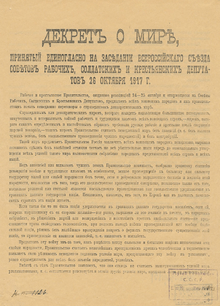Decree on Peace

The Decree On Peace, written by Vladimir Lenin, was passed by the Second Congress of the Soviet of Workers', Soldiers', and Peasants' Deputies on the 8 November [O.S. 26 October] 1917, following the success of the October Revolution. It was published in the Izvestiya newspaper, #208, 9 November [O.S. 27 October] 1917. It proposed an immediate withdrawal of Russia from World War I.
It has been argued that Woodrow Wilson's famous "Fourteen Points" of January 1918 were partly a response to this Decree.
Extracts
The Workers' and Peasants' Government, created by the revolution of October 24-25, and drawing its strength from the Soviets of Workers', Soldiers', and Peasants' Deputies, proposes to all warring peoples and their governments to begin at once negotiations leading to a just democratic peace.
A just and democratic peace for which the great majority of wearied, tormented and war-exhausted toilers and labouring classes of all belligerent countries are thirsting, a peace which the Russian workers and peasants have so loudly and insistently demanded since the overthrow of the Tsar's monarchy, such a peace the government considers to be an immediate peace without annexations (i.e., without the seizure of foreign territory and the forcible annexation of foreign nationalities) and without indemnities.
The Russian Government proposes to all warring peoples that this kind of peace be concluded at once; it also expresses its readiness to take immediately, without the least delay, all decisive steps pending the final confirmation of all the terms of such a peace by the plenipotentiary assemblies of all countries and all nations.